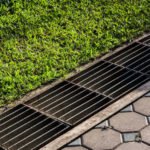In this article we will look at how to lay paving stones. By the way, paving stone is paved not only on the garden paths, but also on the grounds for recreation, entrances to the garage; cultivated her place next to the pool, laid around any suburban facilities: baths, terraces, gazebos, porch and other buildings. You can even make borders for flower beds out of it or contour garden sculptures. The variety of species, shapes and colors of modern paving is simply amazing.
How beautiful to lay paving stones
The main types of laying are only three:
- arcuate;
- arbitrary;
- regular row.

And some laid paving stones in the form of floral or floral print, surreal and cosmic scenes or other beautiful ornament. Be creative and you! After all, such a useful thing as laying paving stones with your own hands, you can turn into a real creativity.
How to choose paving stones
When you decide what pattern you want to see under your feet, choose the appropriate type and size of paving. And if you are a supporter of natural style in landscape design, consider the options of stone blocks made of natural stone or cheaper artificial stone.

Paving technology
In this case, the technology is very important: the durability and beauty of the future site depends on its compliance. And the main condition of quality installation — careful preparation of the base. The ground is well leveled, removing large stones and plant roots; pits fall asleep. Then a well-leveled surface tamped with a pneumatic or electric tamper.
Plot planning
First of all, take a plan of your plot, copy it onto graph paper and designate the places that you will be paving. Based on the area for paving, calculate the number of paving stones, adding to it 10% for a possible marriage. Estimate how much rubble, sand or cement you need. Purchase the desired material. And start the work on laying paving stones with the installation of pegs at a distance of 1-1.5 m from each other. Keeps the pegs together with a nylon cord.
Excavation
The soil is removed to such a depth that the entire surface of the paved area reached the desired level. It can be equal to the surface of the earth or slightly higher, but in any case not lower — otherwise on the paved areas will accumulate water after rains.
Substrate preparation
The basis dug under laying of a stone blocks can be filled up with sand or gravel. If the soil is dense, you can use a layer of sand 5-20 cm, and if the soil is loose, it is better to fill the base with gravel to a height of 10-15 cm. A layer of gravel or sand should also be compacted.
Experts advise even on dense soils under a layer of sand to pour rubble, so that the tile is not subsequently deformed. For areas with difficult terrain used cementing or concreting. If you decide to do cementing, take 3 pieces of fine sand on 1 part of cement. The height of cement “cushion” needs to be 4-5 cm For greater strength paving can be used a three-layer base: gravel + sand + cement.
The design of the border
A curb attached to the pavement a kind of perfection. As a border, you can use paving stones larger than the one you are paving the site, or apply special, ready-made borders for construction. If you want to contour the paved areas with a border, then along the nylon cord, dig an additional trench. Prepare the cement mortar.

It is unacceptable to fill the entire trench with a solution at once, some of it will simply dry out, so pour it as you install the curb. The edge of the border should be in contact with the stretched nylon cord, and each subsequent element — closely adjacent to the previous one.
To create a stronger border, use a edged Board, which must first be fixed in the trench, and then, close to it, strengthen the border tile.
Laying pavers on the base
Start laying paving stones should be no earlier than a day after the installation of the curb — it should dry thoroughly. If you use a sand base, pour it with plenty of water before laying the tiles.
Lay the stone blocks side by side with each other, adhering to the pre-selected pattern. Align the cover by using, and the bars as required, tamp with a rubber mallet. If necessary, cut the pavers . This may be required when you will make out complex areas, for example, put the paving stones around the porch or garden sculpture.

After laying the pavers, it is desirable to seal the entire paved surface with a vibrating rammer. Only use a special rubberized base, so as not to damage the tile. In this way, the laying of different types of paving stones: clinker, granite, stone and others.
The final stage of paving
After you carefully laid out the tile, strengthened and compacted it, fill the paved area with fine wet sand, trying to close the joints. Then it is desirable to seal the area again.

Use the company website only pure fine sand. If in its structure there is at least a little earth with seeds of weeds, they will soon germinate between tiles that is fraught with sad consequences for paving.
Well, now you know how to put paving stones with your hands. Good luck to you in this difficult laborious business.


















